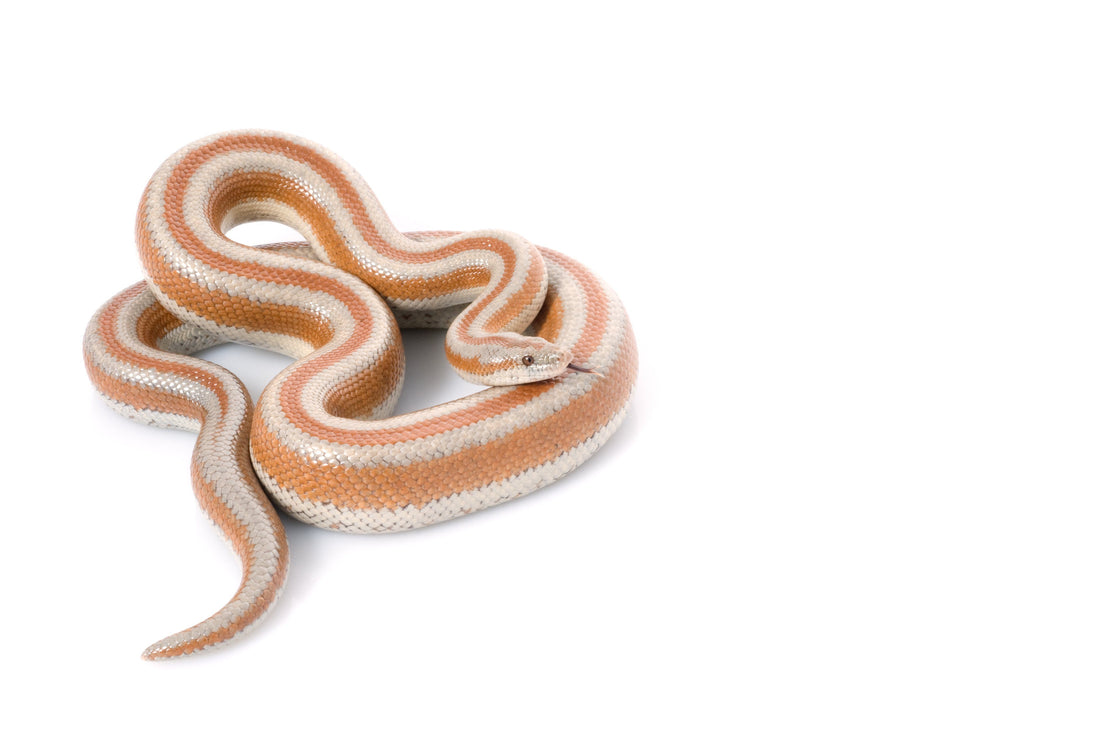The rosy boa (Lichanura trivirgata) is an 18-44” long, terrestrial snake native to the southwestern United States, northern Mexico, and the Baja peninsula. They prefer rocky mountain slopes and dry shrublands with an arid to semi-arid climate.
Rosy boas have thick bodies, slender heads, smooth scales, and vertical pupils. Color and pattern varies depending on individual habitat, although all rosy boas have three broad stripes running down the length of their body. Sometimes these stripes are quite distinct, while in other cases they are less well-defined. The stripes can be orange, red, brown, or black. Base color can be white, cream, tan, yellow, or gray.
Rosy boas are beginner-level pet reptiles due to their manageable size, general hardiness, and docile temperament. With good care, they can have a 25+ year lifespan.
Minimum terrarium size for rosy boas
The minimum terrarium size for one rosy boa is 36”L x 18”W x 18”H, although larger will always be better if you have the space for it. The more room your rosy has, the more opportunities it has for thermoregulation, exercise, and exploration.
Cohabitation (keeping multiple rosy boas in one enclosure) is not recommended, as these snakes are not a social species, and keeping them together causes unnecessary stress.
Do rosy boas need UVB?
Technically they can survive without it, but we still recommend providing appropriate UVB lighting to rosy boas. UVB lighting helps provide a clear day/night cycle, provides all of the vitamin D that your pet needs, strengthens the immune system, facilitates better digestion, and other benefits.
These are the best UVB bulbs for rosy boas:
- Zoo Med T8 Reptisun 5.0
- Arcadia ShadeDweller
For best results, house the UVB bulbs in a reflective fixture. Position the lamp on the same side of the terrarium as the heat lamp, 10-13” above the basking surface. And don’t forget to replace your bulb every 12 months!
UVB is blocked by glass and plastic, so placing the terrarium in front of a window doesn’t count as “free UVB” — in fact it can make your terrarium too hot due to the greenhouse effect.
Lights should be on for 14 hours/day during summer and 10 hours/day during winter. For best results, transitions in day length should be accomplished gradually.
Best temperature for rosy boas
Like other reptiles, rosy boas are cold-blooded, which means that they rely on external temperatures to manage their own body temperature and metabolism. A reptile’s enclosure should offer a range of temperatures to allow them to thermoregulate effectively.
Specifically speaking, rosy boas should have a basking surface temperature of 90°F and a cool side temperature between 70-75°F. Temperatures in each location should be monitored with a digital probe thermometer.
Provide heat for your snake with at least one halogen flood heat bulb. Do not use ceramic heat emitters (CHEs), heat mats, red bulbs, or blue bulbs, as these are not as effective. Heating should be turned off at night.
Best humidity levels for rosy boas
Rosy boas prefer a fairly dry environment with average air humidity levels under 60%, as measured by a digital probe hygrometer placed in the middle of the enclosure. However, it’s best practice to offer a humid hide where they can go when they need more moisture, such as when preparing to shed.
Best substrate for rosy boas
Aside from helping maintain healthy humidity levels and facilitating natural behavior, providing a layer of substrate in your rosy boa’s enclosure helps make your enclosure more attractive and easier to clean!
We recommend the following substrates for rosy boas:
Substrate should be completely replaced every 3-4 months. Remove poop and urates daily, along with contaminated substrate.
How to decorate a rosy boa terrarium
An empty terrarium makes for a bored rosy boa, reducing its quality of life. Keep your pet entertained and engaged with its environment with the strategic use of décor items that encourage it to exercise natural behaviors!
Here are some ways to enrich your rosy’s terrarium:
- flat rocks/paver stones
- hides/caves
- sturdy branches
- cork flats/tubes
- live or artificial plants
What to feed to a rosy boa
Rosy boas are carnivorous, which means that they need to eat whole animal prey in order to get the right nutrition. Here is a basic feeding schedule:
- Babies and juveniles — every 5-7 days
- Adults — every 10-14 days
Prey items should be 1-1.5x the snake’s width at its widest point. Frozen prey should be thawed in a BPA-free plastic bag in warm water until it reaches ~100°F, then use a pair of soft-tipped feeding tweezers to offer it to your snake. To reduce the chances of substrate ingestion, you can use a paper plate.
One of the keys to great nutrition is variety, so aside from offering mice, you can also try young rats, and button quail.
Supplements
Rosy boas can survive without supplementation, but using them every once in a while can help prevent your snake from developing a nutritional deficiency, helping it live healthier. We recommend Repashy Calcium Plus LoD, lightly dusted on the prey item before offering.
Water
Of course, don’t forget a water bowl for your snake to drink from and soak in! Change the water daily and scrub the bowl with a reptile-safe disinfectant weekly, or whenever it becomes soiled.
How to handle your rosy boa
Reptiles generally don’t appreciate petting and handling in the same way that dogs and cats do. That being said, rosy boas generally tolerate human interaction pretty well! When picking up your rosy, be gentle and try to pick it up from the side or below rather than from above. Support as much of its body as possible, and NEVER pick it up by its tail, as this can damage its spine!
*This care sheet contains only very basic information. Although it’s a good introduction, please further your research with high-quality sources. The more you know, the better you will be able to care for your pet!











